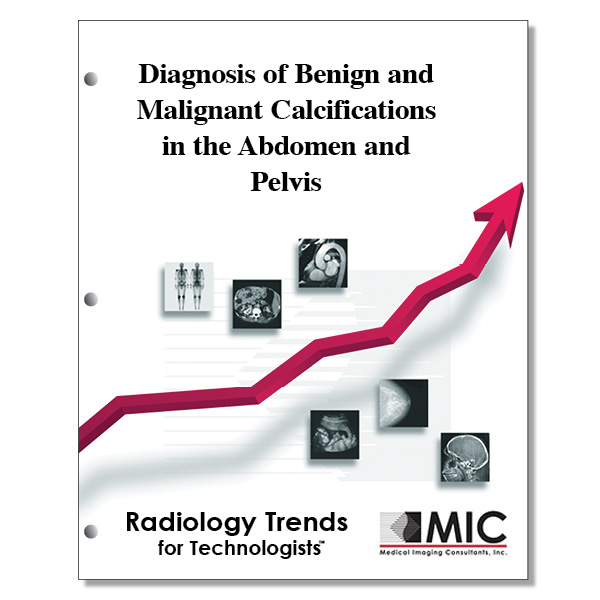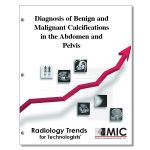

Diagnosis of Benign and Malignant Calcifications in the Abdomen and Pelvis
A summary of various common and uncommon calcifications in the abdomen and pelvis, primarily using location to illuminate diagnostic significance.
Course ID: Q00630 Category: Radiology Trends for Technologists Modalities: CT, Nuclear Medicine, Radiation Therapy, Radiography, Sonography2.5 |
Satisfaction Guarantee |
$29.00
- Targeted CE
- Outline
- Objectives
Targeted CE per ARRT’s Discipline, Category, and Subcategory classification:
[Note: Discipline-specific Targeted CE credits may be less than the total Category A credits approved for this course.]
Computed Tomography: 2.00
Procedures: 2.00
Abdomen and Pelvis: 2.00
Magnetic Resonance Imaging: 1.75
Procedures: 1.75
Body: 1.75
Nuclear Medicine Technology: 1.75
Procedures: 1.75
Endocrine and Oncology Procedures: 1.75
Registered Radiologist Assistant: 2.50
Procedures: 2.50
Abdominal Section: 2.50
Sonography: 1.75
Procedures: 1.75
Abdomen: 1.75
Radiation Therapy: 2.00
Procedures: 2.00
Treatment Sites and Tumors: 2.00
Outline
- Introduction
- Pathophysiology of Calcium Deposition in the Abdomen
- Basic Imaging Principles for Detection of Calcium
- Abdominal Calcifications
- Mesenteric Calcifications
- Benign
- Malignant
- Peritoneal Calcifications
- Benign
- Malignant
- Retroperitoneal Calcifications
- Benign
- Malignant
- Organ-Based Calcifications: Liver
- Benign
- Malignant
- Organ-Based Calcifications: Gallbladder
- Organ-Based Calcifications: Spleen
- Organ-Based Calcifications: Pancreas
- Benign
- Malignant
- Organ-Based Calcifications: Adrenal Glands
- Benign
- Malignant
- Organ-Based Calcifications: Kidneys
- Benign
- Malignant
- Organ-Based Calcifications: Collecting System
- Benign
- Malignant
- Organ-Based Calcifications: Reproductive System
- Organ-Based Calcifications: Colon
- Benign
- Malignant
- Vascular Calcifications
- Musculoskeletal Calcifications in the Abdomen
- Conclusion
Objectives
Upon completion of this course, students will:
- be familiar with broad categories of calcifications in the abdomen and pelvis
- identify the imaging modality most sensitive for the purpose of calcium detection in the abdomen and pelvis
- recognize the causes of pathologic calcium deposition in the abdomen
- identify the most common nonmalignant cause of calcifications in the abdomen
- be familiar with the common appearance for vascular calcifications
- be familiar with the mechanism of calcium deposition in the abdomen due to dystrophic causes
- be familiar with the limitations of the MRI technique of SWI for detection of calcium detection in the abdomen
- be familiar with the pattern of calcifications in the LUQ
- be familiar with the most common mesenteric cyst
- be familiar with the benign cause of calcifications in the peritoneum
- identify the malignant causes of calcifications in the urinary bladder
- recognize the use of PET/CT to differentiate between sclerosing mesenteritis and carcinoid tumor
- be familiar with calcification in lymphoma treatment
- be familiar with the most common benign cause for focal calcifications in peritoneum and retroperitoneum
- be familiar with a peritoneal mouse
- be familiar with a gossypiboma due to a retained surgical sponge
- be familiar with the organ most affected by hydatid disease
- identify the best imaging modality for detecting gallstones
- be familiar with the most common cause of malignant peritoneal calcifications in women
- be familiar with the characteristics of neurogenic tumors located in the retroperitoneum
- be familiar with liposarcoma and where it is located in the human anatomy
- be familiar with the common benign lesions leading to calcified hepatic granulomas
- identify the most common primary hepatic malignancy
- be familiar with a porcelain gallbladder
- be familiar with the characteristics of the most common calcifications observed in the spleen
- identify the leading cause of chronic calcifying pancreatitis
- be familiar with the common CT appearance of serous cystic neoplasms in the pancreas
- be familiar with the primary cause for bilateral adrenal calcifications
- be familiar with the common cause of nephrocalcinosis in the medullary of the kidney
- be familiar with the rate of medullary nephrocalcinosis as compared with cortical nephrocalcinosis
- be familiar with the calcification resulting from Corynebacterium urealyticum in the urothelium
- identify the characteristic patterns of calcifications in uterine fibroids due to end stage hyaline degeneration
- recognize the benign tumors of the gastrointestinal tract
- identify the medical conditions prevalent in patients with vascular and end-organ calcifications
- identify the metabolic and autoimmune disorders represented by the acronym CREST
